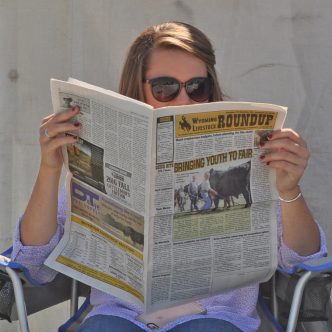It’s The Pitts: Between the SO and LD
I feel sorry for sale managers when they stop a sale and make a long speech telling the crowd the animal in the ring is the best bargain since the Dutch bought Manhattan from the Native Americans for some beads and $24 in cash.
Then, after the momentum of the sale has come to a complete stop, he’ll hand it back to the auctioneer who, despite the speech, can’t find another bid anywhere.
This is why it’s important to have an auctioneer and a ring crew who know intuitively when a person is done bidding. If you watch a bull sale closely, you’ll see a ring man point to the out gate or shake his head, meaning his bidder is done bidding. I used to use my flat hand in an underhand movement like I was pushing the animal out of the ring.
This is especially important in a video sale where TV time can cost over $3,000 an hour and you want to sell as many lots as you can while still getting every dollar for the consignor. Nowadays, where there are often bull sales with 500 bulls and a couple hundred females, a person doesn’t want to be wasting any time.
Years ago, we were selling a high-dollar bull, and the auctioneer thought we’d gathered up all the money we were going to get so he said “SOLD” and slammed his gavel down right before a ring man turned in another bid.
It was obvious to everyone the bull had sold, but the auctioneer made the mistake of saying, “You got me right between the SO and the LD,” and he restarted selling the bull.
The man who’d obviously already bought the bull once became very irritated and ended up buying the bull for $30,000 more than he’d paid the first time. He told the owner he’d never buy another animal at his sale as long as he employed the same auctioneer.
Guess who got fired.
I was the announcer for a big video company for 20 years, and we had six world champion auctioneers. I was on the block 95 percent of the time.
In all of this time, I can’t remember two times we had a similar incident because we had such good auctioneers and excellent ring men. We never wanted to sell a bidder out too soon, but we didn’t want to beg and plead all day either.
A good ring man knows instinctively when a bidder is done bidding and conveys this information to the auctioneer who usually trusts his judgement.
I read one time people who’ve had abusive childhoods make excellent ring men because they had to read the mind of their abusive parent to know when to steer clear. I think there’s something to this theory, because I learned to read my mean, alcoholic father like a book to avoid a scolding, a swat or worse.
I enjoyed my 50 years as a ring man and made a study of it. I read a book a long time ago that said only one-third of communication takes place through the spoken word, and the book explained how to read a person’s tells and non-verbal behavior.
If you watch car auctions on the internet, you’ll see – practically on every lot – a bidder will tell the ring man he’s through bidding but then goes on to bid several more times. To know when he or she really means it, a ring man studies the bidder’s posture, gestures and movements.
If the bidder says they’re done while covering their mouth, scratching their nose, covering their ears or their eyes or blinking a lot, he or she will probably bid again.
But if they offer an open palm in the direction of the person they’re bidding against, he or she is done and the ring man can convey this information to the auctioneer with confidence.
The same goes for a man turning to his wife and saying, “I’m through.”
He dang well better be.
Surprisingly, when a bidder gets up and says, “I’M DONE!” while walking away, it doesn’t necessarily mean he is. I’ve seen countless times where the bidder will stop, turn around and bid again.
Working ring is a lot like playing poker in the Wild, Wild West – only the ring man doesn’t lose any money and no one gets shot. At least so far anyway.





